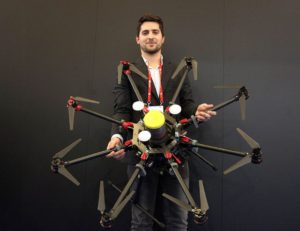
Farms of the Future
Global food demand is forecast to increase 60% by 2050 and world agricultural production needs to increase at a rapid rate to sustain the growing population. Drones are quickly proving their worth in an otherwise time and labor-intensive industry. Pollen interviewed Xavi Silva Garcia (CEO and founder of HEMAV) to find out more about the sector that is tipped to be Australia’s next $100 billion industry…
Founded in Spain in 2012, HEMAV is a technology company that offers data analysis through Artificial Intelligence and the use of drone and satellite images. HEMAV has built a unique system based on Artificial Intelligence using drone technology and other data to provide information and knowledge to the agriculture sector – otherwise known as Agrotech.
How does 2020 look for Agrotech?
2020 is an interesting year as many investors are entering the Agrotech market. Until now there were platforms that weren’t well defined and didn’t provide enough value to the customer, but now there are consistent products that meet the farmer’s expectations.
Do you think the maturity level of Precision Agriculture is equal worldwide?
The market is moving at such a high pace that the term “Precision Agriculture” has become obsolete and is no longer used. Now we talk about “Digital Agriculture”.
The maturity of the market is defined more by the customer (farmer) than the technological capacity of the country. For example, Latin America isn’t known to be technologically advanced but can produce many technologically advanced crops.
Which countries or regions are more advanced in the implementation of this type of service?
It depends on the ownership structure of a country. The larger the structure, the more crop technology is needed to be more efficient. This is the case in Brazil, Argentina, USA and Australia.
On the other hand, countries with a more segmented agricultural surface profile (e.g. Europe) there is not so much need since the farmer has a smaller area and doesn’t need to be as efficient due to lower costs.
What can you tell me about the Australian market and the Digital Agriculture scene?
The Australian market is one with the greatest agricultural potential, having a vast structure, with large fields and a lot of technology.
So, what is the estimated increase of productivity with the use of Digital Agriculture?
It depends on how data is used, but at the level that the sector is and combining data for efficient use of machinery, we currently find increases in production of between 30% and 50%.
How do you overcome the distrust of farmers who don’t believe that a drone with a camera can obtain such productivity increases?
Talking about drones to farmers, in a sector that is not very technologically advanced, catches their attention easily.
On the other hand, it is not possible to apply to Digital Agriculture with just a drone; we need systems, machinery and tools to apply artificial intelligence.
When we enter a geographical market, we usually do it in the hands of a reference producer and when the results are seen (in agriculture word of mouth works very well) the rest of the producers show interest.
Which aspects, other than Digital Agriculture, can farmers use to increase productivity?
FAO says that by 2060 production should increase by 80%, from 80% of the existing agricultural area. Agriculture must be efficient between 60% -70% if it wants to be able to meet global demand.
In a globalised market, you have to be very competitive in price. We see this in the case of big market players that renew the tractor fleet, through a large investment, every 2-3 years since the new model executes the activities twice as fast.
The key is technology, Hardware and Software. Having the right data at the right time helps to make the right decision in terms of harvest logistics, in purchase-sale and planning.
Which crops are Digital Agriculture being applied to most?
It depends on the machinery that encompasses the crop and the use of information. Digital Agriculture ranges from tractors that can spray from plant to plant or operate autonomously with RPK, or specific encapsulated and slow-release products such as fertilizers or chemicals.
Data that has to be transmitted to the machinery is where the gap is today and where “Precision Agriculture” is not precise enough. The key to success is in the accuracy of the data and the sector obtaining that level of precision by combining drones, satellites, light planes, field samples, meteorology and product historical data.
The products where Digital Agriculture is currently applied the most are soybeans, corn and cane.
How do you measure the performance generated by the action of Digital Agriculture on a client?
The methodology we use to measure efficiency is the AB test, where we work on two crop fields at the same time. In one we apply our methodology, and in the other, we continue working as before. This allows us to compare our system with a realistic baseline and allows us to see the impact on production, cost efficiency etc.
How do you think the sector will evolve in the coming years?
The development keys of the sector are focused on technology. To take better advantage of the images obtained with the satellite that allows a constant flow of information with greater precision.
Other aspects are drones and their capacity to apply treatments, fumigate etc. We begin to see the efficient use of those applications where chemical products, which are expensive, are applied only where necessary.
Another key factor is the speed with which information is given in order to make predictions. There is a lot of interest in monitoring tools such as “layers” to make buy-sell estimates.
In the future, we will see fewer people in the field, more technology, more machines and more efficiency. The agricultural sector will increase its technological maturity by leaps and bounds.

Xavi Silva Garcia – CEO and founder of HEMAV
Interview by Younes Souirji Gomez – Consultant at Pollen Consulting Group